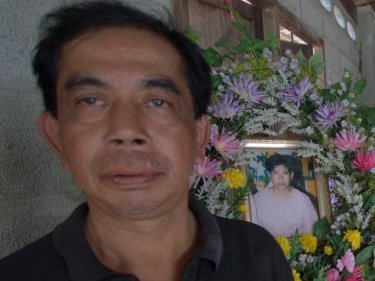See more in our photo album
WHEN THE family of tsunami victim Tuanjai Pleekarn cremated her body in Phang Nga on Sunday, it was the second time they had conducted the Buddhist ceremony for her.
The first cremation turned out to be a mistake. The body actually belonged to someone else.
Tuanjai and the female who was originally cremated under her name were both victims of the big wave that struck Thailand and the whole Indian Ocean rim on December 26, 2004, killing perhaps 220,000 people.
Now, almost four years on, Tuanjai's family has had to go through the anguish of a misidentification and a second cremation.
Giving names back to tsunami victims in Thailand has long been world's largest forensic detective investigation.
And before it draws to a close, as matching of DNA samples continues, more incorrect identifications are likely to be revealed.
Other victims of wrong tsunami identifications may not be as fortunate as the Pleekarn family.
Some who today believe they have closure may also have been given the wrong body.
AFTER THAT first cremation, Tuanjai's husband Nattapong scattered the ashes that he believed belonged to his wife.
But as a loving husband, he kept the teeth, which had survived the fire, in a box, as a memento.
Earlier this year, when officers from the Thai Tsunami Victim Identification unit (TTVI) came knocking at his home in a village close to the Phang Nga coastal township of Takuapa, he was able to provide them with those teeth.
DNA tests on one of the couple's two children confirmed the suspicions of TTVI investigators: the wrong body had been returned.
Just how such serious mistakes came in a process designed to prevent them, and how many were actually made, is now being looked at closely.
The possibility of wrong identifications has not been publicly discussed before yet now that prospect is being talked about widely in Phang Nga, around Takuapa and Khao Lak, where most of the tsunami victims died.
In the aftermath of the tsunami, police, forensic pathologists, dentists and DNA and fingerprint experts from 39 countries joined forces under the TTVI banner with the express intention of accurately identifying every one of the 5395 victims in Thailand.
Quite properly, the process of identification has been treated as a private one between investigators and the family of victims.
The Pleekarn family, having been approached by Phuketwan, has chosen to tell their story.
What the Pleekarn family says will resonate with many families in Germany, Sweden, Britain, Finland, Switzerland, France, Austria and Norway. The majority of the 2700 non-Thai victims were Europeans.
IN THE days immediately after the tsunami, the Andaman coast of Thailand was littered with the bodies of tourists, local resort staff and Burmese laborers, people unlucky enough to be caught up in the swirling water that Sunday morning.
The washing machine action after the wave carried bodies from one part of the coast and deposited them, often minus clothing, in other parts. Some resorts where there were no victims had their foreshores dappled with dead.
Only a few bodies were swept out to sea. Over the days that followed, volunteers collected hundreds of victims and carried them to two local temples, where they were laid out in body bags cooled by dry ice.
Into this surreal and chaotic world at Wat Yan Yau in Takuapa, 12 days after the tsunami, walked Tuanjai's elder sister, Duangdean.
She saw a face on a wall among many photographs of bloated victims and identified her younger sister.
A body was given to the family the same day and the cremation took place three days later. Soon after, Khun Nattapong put the teeth aside for safekeeping.
To this day, despite the conclusive DNA evidence, Khun Tuanjai's elder sister, the family says, still believes her sister's body was consumed in the first cremation.
She did not attend the second ceremony.
Forensic experts say that amid the trauma of a horrific event such as a tsunami, there is a one-in-five chance of a visual identification being wrong, no matter how sure the person happens to be about the victim's identity.
Scott Carter, an American who arrived in Thailand in mid-January 2005, answered a request and volunteered to work among the bodies as an ''image Photoshopper''.
He described the process this way:
''We would take photos of the faces of the victims' corpses and, based on the doctors' experience and knowledge of necrosis, manipulate the image digitally to 'reverse' that process.
''I felt that other than the first four or five days, the touch-ups we were making were becoming more and more based on imagination than forensic reconstruction.
''I'm not meaning to impugn the technical expertise of the professionals I worked under, but it was hard for me to imagine how what we were doing was in any way returning the faces to an accurately recognisable state.
''I privately came to feel that we were doing more harm than good. The doctors weren't dealing with real human flesh any more but simple scanned Polaroids.''
It was from manipulated images such as these, or in some cases the distorted corpses themselves, that many identifications were made before the TTVI took over the process on February 6, 2005.
From then on, rigorous international scientific standards were imposed.
Because of the need for privacy, details about the return of bodies are not always forthcoming.
One embassy source told Phuketwan that about 1910 bodies are believed to have been returned in the first 40 days, before the TTVI took over, many of them solely on the basis of visual identification.
Only much later, in 2006, were the DNA samples that had been taken from the early identifications finally handed over to the TTVI team, which by then was a much smaller operation run solely by Thai officers.
AT LEAST five sets of cremated remains are understood to be among the 388 unidentified victims, most of whom lie in a special cemetery 10 kilometres from the home of the Pleekarn family.
The cremated remains indicate that the likelihood is that more mistaken identities have yet to be revealed. Every wrong identification prevents at least one other family from finding closure.
Do you have something to add on this issue? Please tell us in the Comment box below
Other difficulties, political and personal, hamper the work of the small remaining team of Thai forensic detectives.
Twenty-four bodies, identified as Burmese, await collection in a handful of cooled shipping containers at the TTVI repatriation centre in Phang Nga. But the junta government refuses to concede that they are citizens of Myanmar.
Another body, that of a Nepalese man, identified on January 18, 2006, still awaits a reunion. His relatives have been told he has been identified.
At least one other Thai family is understood to have been informed by the TTVI that they claimed the wrong body. But that family, we have been told by a reliable source, rejected the opportunity to right the wrong.
And now, there is an added mystery: the identity behind the teeth returned by the Pleekarn family from that first cremation.
World's largest forensic detective saga continues, but with unexpected twists.
''I feel bad about this mistake,'' Khun Nattapong told Phuketwan. ''It should not have happened.''
Essential Reading
Bodywork: How Tsunami Victims Reclaimed Names
The work by international police created the greatest forensic detective saga in history. Here is a report from the first 100 days.
Bodywork: How Tsunami Victims Reclaimed Names
The Man Who Waits in The Cool Container
Lost and found. Those three words tell a tsunami story that applied to thousands of victims. But for one of the lost and found, there has been no reunion with loved ones. And there may never be.
The Man Who Waits in The Cool Container
Water and Fire: A Tsunami Reunion
The poorest unidentified victims of the tsunami in Thailand are the ones who still have yet to be reunited with relatives. Here is a report of one reunion.
Water and Fire: A Tsunami Reunion
Tsunami Warning Test: How Safe Are We?
Warning drills for a tsunami are easy in sunshine. But the unpredictable arrival of a big wave in the middle of the night, when telephones and television are switched off, leaves us asking: How safe are we?
Tsunami Warning Test: How Safe Are We?
Tsunami Warning: 'Resorts to Blame'
The lessons of the 2004 tsunami have not been learned. And for the first time, the reliability of the big wave warning system is being questioned. An adequate answer is essential.
Bodywork: How Tsunami Victims Reclaimed Lives
US Calls For Tsunami ID work To Continue
A US grant to Thailand of up to $1.5 million to assist in restoring names to victims of the Asian Tsunami expires on March 31. But a scandal continues to obscure the future of the identification process.
US Calls For Tsunami ID work To Continue
Thai Official Accused of Tsunami Corruption
Accusations of corruption by a Thai official take the edge off a generous international tsunami project that involved about 40 countries and gave names back to thousands of unidentified victims.
Thai Official Accused of Tsunami Corruption
Tsunami Victims: Fate of Cemetery Being Discussed
Senior officials have been discussing the future of the cemetery in Phang Nga that houses the remaining bodies of unidentified victims, most poignant of all the tsunami sites.
Tsunami Victims: Fate of Cemetery Being Discussed
A version of this article first appeared in the South China Morning Post in Hong Kong on October 17.










Here's hoping that everyone involved in the tsunami identity project gets the right body returned, and soon. Thailand did the correct thing in trying to identify everyone who died there in the big wave. What is happening now? It's hard to tell. The TTVI has an obligation to more than 30 other countries and must explain what is happening. Many families from around the world are still waiting to have the bodies of their loved ones returned. The system needs to be 99 percent perfect for that to happen. Can Thailand get it right? I hope so.
Posted by chutima on October 17, 2008 16:16